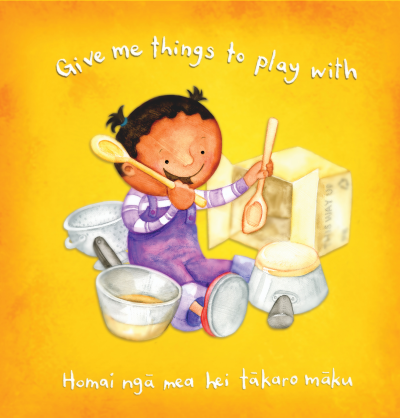
All things unstructured play
Unstructured play using everyday objects provides opportunities for tamariki to use their imagination, supporting their creativity, emotional development, and problem-solving skills.
Unstructured play (sometimes called free play) sounds fancy, but only means play that tamariki spontaneously lead, is free from adult rules and intervention, and uses ‘things’ that don’t serve a particular purpose. These may include everyday objects like kōhatu , rākau , string, art supplies, a ball or blocks, or kitchen items.
Heuristic play is another name for unstructured, free play. The kind of play where pēpi and tamariki interact with everyday objects instead of proper toys, providing an opportunity for open-ended discovery.
What might it look like?
An example of unstructured play might be that when whānau are pegging up washing, pēpi joins them. Pēpi enjoys taking the pegs from the container and lining these up. Pēpi then uses the pegs as cars racing each other and progresses to using their imagination in driving a car, miming the steering wheel in their hands.
Whānau can contribute to the learning opportunity by commenting on what pēpi is doing: “You’ve got 1, 2, 3 pegs pēpi, all lined up. A red one, a kōwhai one…” They might also make car noises and run around the lawn following pēpi and where they lead this playtime.
Why is this kind of play important?
Research shows that unstructured playtime fosters children’s imagination, creativity and ideas as they ‘invent’ their own games and activities.
Often unstructured play includes other people or imagined people which supports tamariki to develop social skills, positive interactions and problem-solving.
It’s also important in promoting independence because they decide what happens next and build confidence in their decision-making abilities.
As well as this it supports physical development – running, jumping, hopping, skipping or fine motor skills when they choose something less active, like playing with pegs.
There are many benefits to unstructured play opportunities for tamariki. Kindergartens, preschools, kōhanga reo and kura also offer unstructured play to support learning because it allows tamariki to explore in the ways that suit their learning style and with their interests in mind. Unstructured play is now known to support curiosity in order for tamariki to keep exploring and finding things out while having fun!
Conversation ideas
Learn more
Learning is child's play
Brainwave Trust Aotearoa
During the early years, it is play and ‘ordinary life’ that contributes the most to brain development for tamariki.
Unstructured play
Sport New Zealand
How play opportunities using abstract, recycled materials are helping to unleash creativity in children and help them learn.
Helpful resources for whānau
-
The magic of heuristic play
Playcentre Aotearoa
Play is how children best make sense of the world. Read more on heuristic play from Playcentre Aotearoa.
-
Play and learning 1 to 2 years
Whānau Āwhina Plunket
This page from Whānau Āwhina Plunket has information on why play is important, types of play and play ideas.
 pdf 1.2 MB
pdf 1.2 MB












